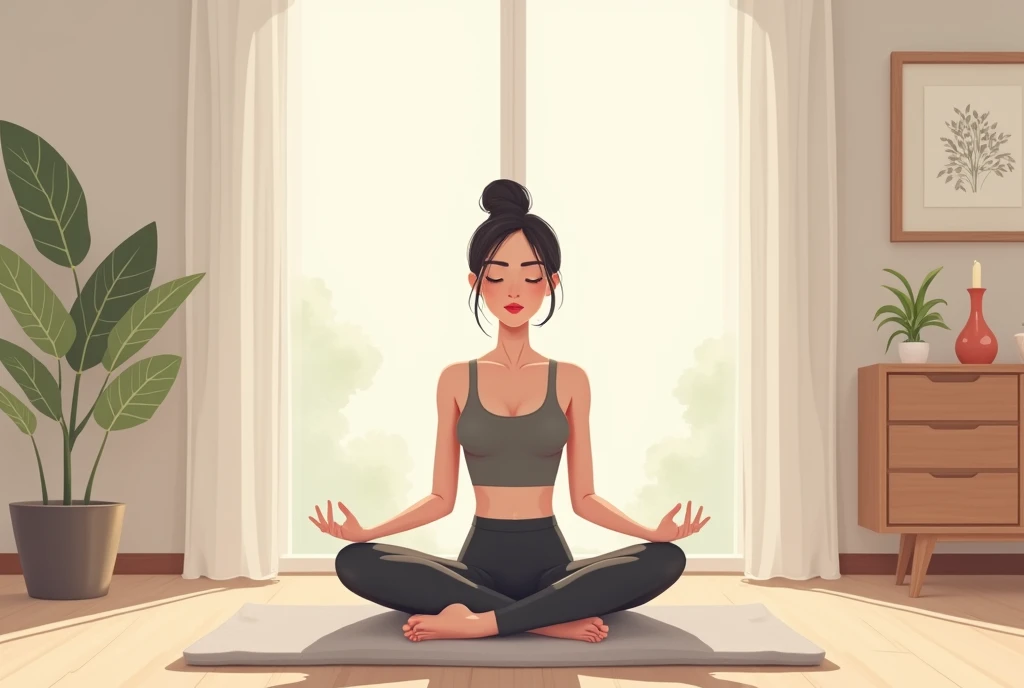In today’s fast-paced, stress-filled world, more and more people are turning to meditation as a way to find inner peace, reduce anxiety, and improve overall well-being. If you’re new to meditation and wondering how to start your practice at home, you’ve come to the right place. This comprehensive guide will walk you through the what, why, and how of meditation, addressing common concerns and providing practical tips to help you begin your journey to mindfulness.
What is Meditation?
Meditation is often misunderstood as simply sitting still with your eyes closed. However, as Sadhguru, a renowned spiritual leader explains, meditation is not something you do, but rather a quality you cultivate. It’s a consequence of a certain process, much like how flowers are the result of proper gardening.
At its core, meditation is about creating a space between your physical body, your mind, and your true self. It’s a state of consciousness where you are aware of your thoughts and feelings but not controlled by them. This state allows you to observe your mind without getting caught up in its constant chatter.
Why Meditate?
The benefits of meditation are numerous and scientifically proven. Here’s a deeper look at why you should consider incorporating meditation into your daily routine:
- Stress Reduction: Meditation activates the body’s relaxation response, lowering cortisol levels and reducing overall stress.
- Improved Focus and Concentration: Regular meditation practice has been shown to increase the brain’s ability to focus and maintain attention for longer periods.
- Enhanced Emotional Well-being: Meditation can help regulate mood and anxiety disorders, promoting a more positive outlook on life.
- Increased Self-awareness: By observing your thoughts and feelings without judgment, you gain a better understanding of yourself and your patterns of thinking.
- Better Sleep: Meditation can help calm the mind, making it easier to fall asleep and improving overall sleep quality.
- Physical Health Benefits: Studies have shown that meditation can lower blood pressure, boost the immune system, and even reduce chronic pain.
- Improved Relationships: By increasing empathy and emotional regulation, meditation can lead to better interpersonal relationships.
Moreover, as Sadhguru points out, meditation is a powerful tool that allows you to engage fully with the world while remaining untouched by its chaos. It’s not about disconnecting from life, but rather about living more fully and consciously.

Common Concerns About Meditation
Before we detailed into the how-to, let’s address some common concerns that many beginners have:
- “I can’t stop my thoughts.” This is perhaps the most common concern among meditation beginners. The truth is, you’re not supposed to stop your thoughts entirely. The goal of meditation isn’t to create a blank mind, but to observe your thoughts without getting caught up in them. Think of your mind as a sky and your thoughts as clouds passing by. You’re just watching them drift past without attaching to any particular cloud.
- “I don’t have time.” In our busy lives, finding time for anything new can seem challenging. However, meditation doesn’t require hours of your day. Start with just 5-10 minutes. Everyone can find this much time, whether it’s right after waking up, during a lunch break, or before bed. Consistency is more important than duration when you’re starting out.
- “I’m not doing it right.” There’s no “right” way to meditate. As long as you’re setting aside time for the practice and making an effort to focus your attention, you’re doing it right. Meditation is a skill that improves with practice, so don’t worry if it feels awkward or difficult at first.
- “It’s too difficult.” Like any new skill, meditation takes practice. It’s normal to find it challenging at first. Start with guided meditations or simple breathing exercises. Be patient with yourself and remember that even experienced meditators have difficult sessions sometimes.
- “I fall asleep.” If you consistently fall asleep during meditation, it might be a sign that you’re not getting enough rest. Try meditating at a different time of day when you’re more alert. Alternatively, you could try meditating in a seated position rather than lying down.
- “I don’t feel any different.” The effects of meditation are often subtle and cumulative. You might not notice dramatic changes right away, but with consistent practice, you’ll likely start to see benefits in your daily life. Keep a journal to track your progress over time.
- “I’m not spiritual/religious.” While meditation has roots in various spiritual traditions, it doesn’t require any specific beliefs. Many people practice meditation purely for its scientifically proven health benefits.
How to Meditate at Home: A Detailed Guide
Now that we’ve addressed common concerns, let’s dive into a step-by-step guide on how to meditate at home:
- Find a Quiet Space: Choose a quiet, comfortable place where you won’t be disturbed. This could be a corner of your bedroom, a comfortable chair in your living room, or even a spot in your garden. The key is to find a place where you feel relaxed and can minimize distractions.
- Get Comfortable: Sit in a comfortable position. You can sit cross-legged on the floor, on a cushion, or in a chair with your feet flat on the ground. The important thing is to keep your back straight but not rigid. This helps maintain alertness and promotes good circulation. If sitting is uncomfortable, you can also meditate lying down, though this may increase the likelihood of falling asleep.
- Set a Time Limit: For beginners, 5-10 minutes is a good start. As you become more comfortable with the practice, you can gradually increase the duration. Using a timer can help you relax without worrying about how much time has passed.
- Focus on Your Breath: Close your eyes and focus on your breath. Notice the sensation of air moving in and out of your body. Feel the rise and fall of your chest or the expansion and contraction of your belly. You don’t need to change your breathing pattern; simply observe it as it is.
- Notice Your Thoughts: As you focus on your breath, you’ll notice that your mind starts to wander. This is completely normal and part of the process. When you notice your mind has wandered, gently bring your attention back to your breath without judgment. This act of noticing and returning is the core of meditation practice.
- Be Kind to Your Wandering Mind: Don’t judge yourself for having thoughts or get frustrated when your mind wanders. This is what minds do. Instead, practice observing your thoughts without getting caught up in them. Each time you notice your mind has wandered and you bring it back to your breath, you’re strengthening your meditation muscle.
- Use Guided Meditations: If you’re finding it difficult to meditate on your own, try using guided meditations. There are many apps and YouTube videos that offer guided meditations for beginners. These can be incredibly helpful in providing structure and maintaining focus.
- Experiment with Different Techniques: There are many different meditation techniques. Some people prefer focusing on the breath, while others might use a mantra (a repeated word or phrase), or practice body scan meditations. Experiment with different techniques to find what works best for you.
- End with Kindness: When your timer goes off, don’t abruptly end your meditation. Take a moment to notice how your body feels. Notice your thoughts and emotions. Gradually open your eyes and take in your surroundings. Try to carry this sense of awareness with you into the rest of your day.
A Simple Meditation Technique: Isha Kriya
Sadhguru recommends a simple but powerful technique called Isha Kriya. This meditation involves three key ingredients:
- Your breath
- Your thought
- Your awareness
Here’s a basic outline of the Isha Kriya practice:
- Sit cross-legged with your spine comfortably erect. Keep your hands upon your thighs, palms facing up.
- Face slightly upward, closing your eyes and letting them become soft.
- Inhale and exhale slowly and gently.
- On the inhalation, mentally say to yourself “I am not the body.” On the exhalation, mentally say “I am not even the mind.”
- Repeat this process for 7 to 11 minutes.
- After this, keep your eyes closed and sit still for 5-6 minutes.
By combining breath, thought, and awareness in this way, you can enhance your ability to use your mind and body effectively.
Tips for Establishing a Regular Meditation Practice
- Start Small: Begin with just 5 minutes a day. It’s better to meditate for 5 minutes every day than 30 minutes once a week.
- Be Consistent: Try to meditate at the same time each day. This helps establish a habit.
- Create a Meditation Space: Designate a specific area in your home for meditation. This helps signal to your brain that it’s time to meditate when you enter this space.
- Use Props: A meditation cushion, bench, or comfortable chair can help maintain proper posture.
- Be Patient: Remember that meditation is a practice. Some days will feel easier than others, and that’s okay.
- Join a Group: Consider joining a meditation group or class. This can provide motivation and support.
- Use Technology Wisely: While it’s good to disconnect, apps like Headspace, Calm, or Insight Timer can be helpful for beginners.
- Keep a Meditation Journal: Write down your experiences after each session. This can help you track your progress and insights.
Conclusion
Meditation is a powerful tool for enhancing your life, but it’s not about escaping reality. Instead, it’s about engaging with life more fully while maintaining inner peace. By starting with just a few minutes a day, you can begin to cultivate a meditative quality that will positively impact all areas of your life.
Remember, the key to meditation is consistency, not perfection. Don’t worry about whether you’re doing it “right.” The simple act of showing up and practicing regularly is what matters most. Over time, you’ll likely find that meditation becomes not just a practice, but a way of life one that brings more peace, clarity, and joy to your daily experiences.
Start your meditation journey today, and remember – every moment is an opportunity to be mindful. Happy meditating!



GIPHY App Key not set. Please check settings